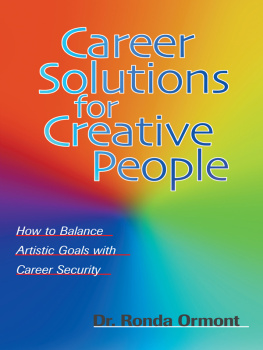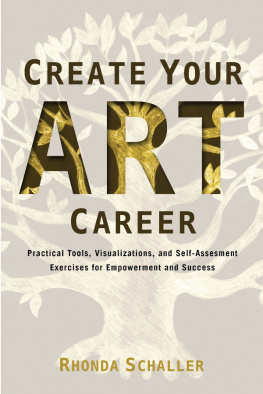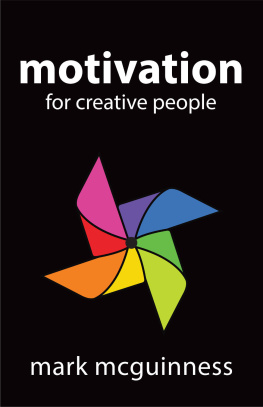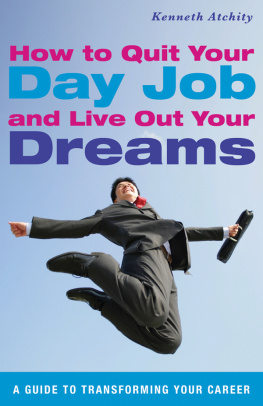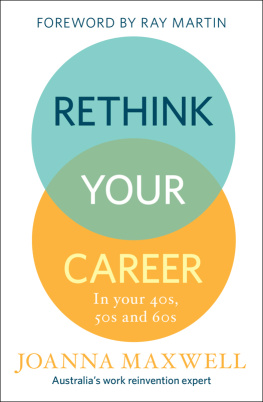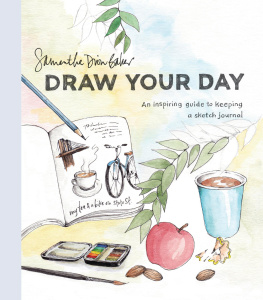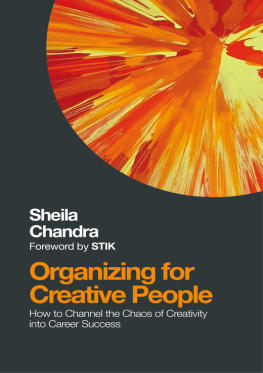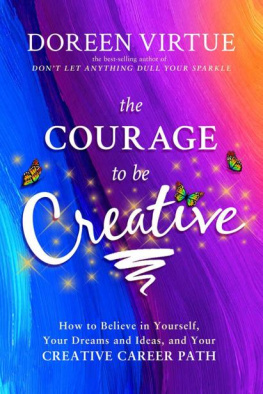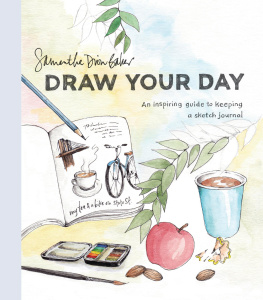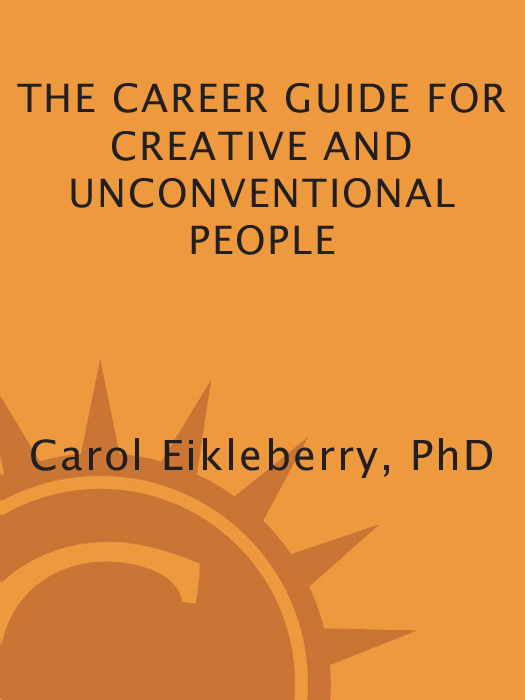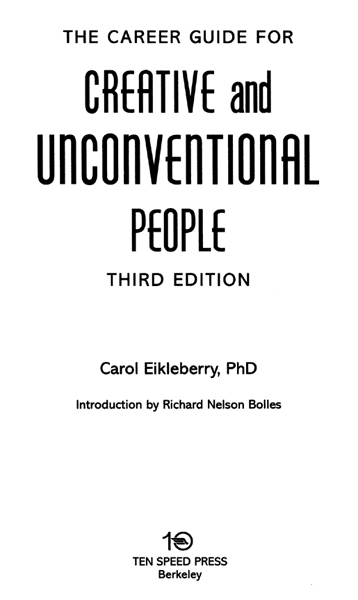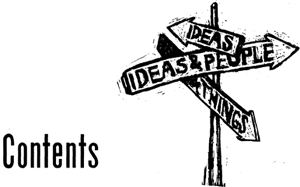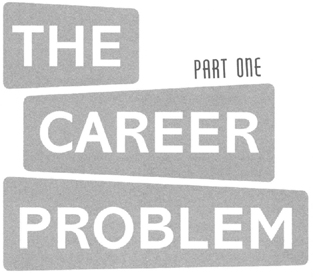Copyright 2007 by Carol Eikleberry.
All rights reserved. Published in the United States by Ten Speed Press, an imprint of the Crown Publishing Group, a division of Random House, Inc., New York.
www.crownpublishing.com
www.tenspeed.com
Ten Speed Press and the Ten Speed Press colophon are registered trademarks of Random House, Inc.
Table on from Rise of the Creative Class by Richard Florida reprinted by permission of Basic Books, a member of Perseus Books, L.L.C. Used with permission of Richard Florida. Copyright 2001. All rights reserved.
Library of Congress Cataloging-in-Publication Data
Eikleberry, Carol.
The career guide for creative and unconventional people / Carol Eikleberry; introduction by Richard Nelson Bolles. 3rd ed.
p. cm.
Summary: The revised third edition of the popular career guide for offbeat individuals seeking work that suits their unique skills, talents, and passionsProvided by publisher.
1. Vocational guidance. 2. Creative ability. I. Title.
HF5381.E485 2007
331.702dc22
2006103028
eISBN: 978-0-307-76850-6
Illustrations by Ann Miya on
v3.1
270 Occupations for Creative and
Unconventional People
For the late Elizabeth Betsy Brewer
whom I would have chosen to be
my own career counselor
Acknowledgments
My first acknowledgment goes to Emeritus Professor Jerald Forster of the University of Washington, who suggested during a 1983 lecture on career counseling that someone should write a career book for Hollands Artistic types. In my minds eye, all these years later, I can picture the spot where I sat in his classroom as I straightened up and thought: What a good idea! When I told him that Id like to write such a book, he nurtured the project as my advisor, doing what he could within academe to support my goal. It was my great good fortune to be his student.
Id like to extend special thanks to the following people whose work has greatly influenced this book: the editors, illustrators, and designers at Ten Speed Press, whose talents helped me turn my ideas into something you might actually want to read; Richard Bolles for his amazing generosity and the model he provides in his book, What Color Is Your Parachute?; and John Holland, for an elegant and practical theory that gave me a new understanding of the work world and my place in it.
Id also like to thank my husband, family, and friends. Many creative people, both clients and friends, shared with me their experiences and ideas. Too many people to remember read my book in its various incarnations and offered suggestions that improved it. I have arranged all their contributions in a way that I hope will be helpful to you, the reader.
Introduction by Richard Nelson Bolles
Many, many books come across my reading table each year, but it has been a long time since one of them impressed me so much as this one has.
Carol has set out to illuminate a very perplexing subjectthat of the creative or unconventional impulse in us all. And I found her insights quite dazzling. alone is worth the price of the book.
I have found myself thinking again and again on some of the things she says. She has struck some deep chords with me.
The reason for this lies in the nature of language. Language is a marvelous invention, when you stop to think about it. Take the English language, for example. It uses just twenty-six symbolswhich we call the letters of the alphabetto describe everything. Millions and millions of things. All labeled or recalled with the aid of those twenty-six symbols.
A man named John Holland has gone the English language one better. He has invented an alphabet of just six symbols, to describe over twelve thousand occupations and their multiple job titles. Johns alphabet has become the most popular system for describing occupations existing in the world today. Over fifteen million copies of his Self-Directed Search, which enshrines that alphabet, have now been purchased and used.
The most significant difference between Johns alphabet and the English alphabet, however, has nothing to do with numbers. It is the fact that in the English language the symbols themselves are used without any deep analysis of each symbol. In Johns alphabet, the six symbols (A, S, E, I, R, and C) are fraught with meaning and significance, and they cry out for analysis. Over the years, that examination has been made, but it is safe to say that the least examined and least understood of Johns alphabetuntil nowhas been the letter A, for Artistic.
Since A not only stands for a number of occupations, but also for a gift which potentially lies within us allthe creative impulsethe examination is long overdue.
Here are some of Carols insights in this book which have particularly impressed me (I state them mainly as I have digested them, with a few in their pristine Carolinian form):
The essence of art or creativity lies in an unusual sensitivity to some aspect of everyday sensory experience, and this sensitivity is something we were born with.
The sensitivity is usually restricted to one area, rather than constituting sensitivity to everything.
The sensitivity may be to pictures, sounds, language, movement, human behavior, values (truth, honesty), or whatever. If you are not sure what your sensitivity is, think about the kinds of ugliness that most distress you.
A persons particular sensitivity brings them both pleasure and pain. An artistic sensitivity to something combines the potential for a sublime experience with the agony of confrontation with the ordinary.
In going about their work, Artistic types prefer to use intuition, which looks for what the senses dont pick up and, most particularly, for the relationships between facts rather than just for the facts themselves.
This tends to lead them to awareness of what is wrong, within their arena of sensitivity. Therefore, creativity begins not with problem-solving, but with problem-findingwith the seeing or sensing of a problem. Creative people focus on what is wrong, what is missing, what needs to be changed to make something better.
And while the emphasis is on problem-finding, as it turns out, the way a problem is set up often suggests the resolution.
Very often the Artistic person is an appreciator rather than a creator If it is hard to make your living by creating, it is doubly hard to make your living by appreciating.
This is just a sampler of the wealth of insights to be found in this book.
And what does all this have to do with job-hunting? Well, in a highly competitive job market, often the key to success is first sitting down and thoroughly trying to understand yourselfbefore you go out there. Knowing who you are and what you have to offer is crucial. Carol has made an important contribution indeed to this self-understanding.


